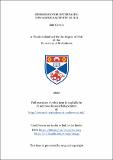Sensorimotor interfaces : towards enactivity in HCI
Abstract
This thesis explores the application of enactive techniques to human computer
interaction, focusing on how devices following ‘sensorimotor’ principles can be
blended with interface goals to lead to new perceptual experiences. Building
sensorimotor interfaces is an exciting, emerging field of research facing challenges
surrounding application, design, training and uptake.
To tackle these challenges, this thesis cuts a line of investigation from a review
of enactivity in the related field of sensory substitution and augmentation devices,
to a schematic taxonomy, model and design guide of ‘the sensorimotor interface’;
developed from a theoretically-grounded, enactive approach to cognition. Device,
interaction and training guidelines are drawn from this model, formalising the
application of the enactive approach to HCI.
A readily-available consumer device is then characterised and calibrated in preparation
for testing the model validity and associated insights. The process highlights
the effects of accessible, easily-implemented calibrations, and the importance of
mixed-method approaches in assessing sensorimotor interface potential.
The calibrated device is utilised to conduct a detailed, methodological investigation
into how concurrently available sensory information affects and contributes to uptake
of novel sensorimotor skills. Robust statistical modelling concludes that sensory
concurrency has a profound effect on the comprehension and integration of enactive
haptic signals, and that efforts to carefully control the nature and degree of sensory
concurrency improve user comprehension and enjoyability when engaging with
novel sensorimotor tasks, while reducing confusion and stress.
The work is concluded by speculation on how the presented derivations, methods
and observations can be used to directly influence future sensorimotor interface
design in HCI.
This thesis therefore constitutes a primer to the principles and history of sensory
substitution and augmentation, details the requirements and limitations of the
enactive approach in academia and industry, and brings enactivity forward as an
accessible, viable and exciting methodology in interaction design.
Type
Thesis, PhD Doctor of Philosophy
Collections
Description of related resources
Carson , I , Quigley , A , Clarke , L & Hinrichs , U 2021 , ' Investigating the effect of sensory concurrency on learning haptic spatiotemporal signals ' , Proceedings of the ACM on Interactive, Mobile, Wearable and Ubiquitous Technologies , vol. 5 , no. 1 , 6 , pp. 1-30 . https://doi.org/10.1145/3448102Related resources
http://hdl.handle.net/10023/21746Items in the St Andrews Research Repository are protected by copyright, with all rights reserved, unless otherwise indicated.

